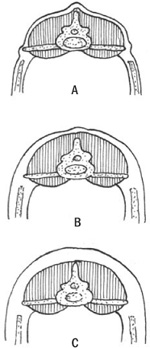12
Showing Sheep
SOME FOLKS ARE INTERESTED IN the world of showing sheep, for themselves, for their children or grandchildren, or even as a chance to positively influence other children who live near them. Showing has some real marketing advantages for purebred breeders, and for fiber breeders who are direct marketing fleece to handspinners and fiber enthusiasts. But showing is also a great deal of work, and it requires a serious commitment. Care of show sheep begins months before the show with grooming and training. There are extra costs associated with showing, such as entry fees, transportation, additional vaccinations, and supplies for fitting (or grooming) your sheep.
This chapter is a brief introduction on how to show sheep — it isn’t intended to be comprehensive. The sheep magazines are excellent sources for anyone interested in showing. The Banner is a general sheep magazine that’s really aimed at those who show sheep. The Shepherd’s Journal covers a lot of showing in Canada. A few other sheep magazines, such as sheep!, Sheep Connection, Sheep Canada, and Sheep Industry News, also provide some coverage for showing.
Kinds of Shows
Shows can either be straight shows with no sales or they may be combined shows and sales. In addition, they fall into two other main categories:
 Registered breed shows, which are sponsored by the breed’s association or some other national sheep organization. These shows are often held in conjunction with state fairs and special expositions, such as the North American International Livestock Exposition and the National Western Stock Show. All animals must have current registration papers, and those papers must be up-to-date and accurate.
Registered breed shows, which are sponsored by the breed’s association or some other national sheep organization. These shows are often held in conjunction with state fairs and special expositions, such as the North American International Livestock Exposition and the National Western Stock Show. All animals must have current registration papers, and those papers must be up-to-date and accurate.
 Open-class shows are not breed specific. Most are local affairs, sponsored through the Cooperative Extension Service and county fair system, though national shows may have open classes where more than one breed is in the ring at the same time. Some of these open shows are for adults, but most are for youth programs, such as 4-H and Future Farmers of America (FFA). In these shows animals are generally not required to have registration papers from a particular breed association, though if one or two breeds are very popular in the area, there may be “classes” in which registered animals compete against each other. These breed classes may or may not be sanctioned by a breed’s association.
Open-class shows are not breed specific. Most are local affairs, sponsored through the Cooperative Extension Service and county fair system, though national shows may have open classes where more than one breed is in the ring at the same time. Some of these open shows are for adults, but most are for youth programs, such as 4-H and Future Farmers of America (FFA). In these shows animals are generally not required to have registration papers from a particular breed association, though if one or two breeds are very popular in the area, there may be “classes” in which registered animals compete against each other. These breed classes may or may not be sanctioned by a breed’s association.
Each show has its own rules and regulations. These rules tell you everything from when entry fees and forms must be submitted, to what health certificates you need to bring, to what criteria the judges use. A copy of the rules should be acquired and studied well ahead of time so your sheep aren’t disqualified for some infraction. If you’re planning on showing in more than one show, get the rules for each — don’t assume that they’re all the same.
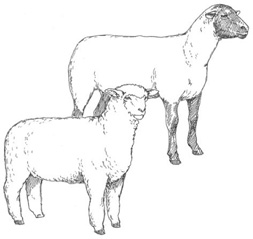
When buying or raising sheep for showing, conformation is important. This sheep shows excellent conformation for a meat breed, with a strong straight back.
This shows the correct conformation for a wool breed, with a slightly sloping back.
Show Classes
In shows there are generally various classes of sheep competing against each other. The classes that have been established for a given show may relate to the age, sex, production type, or breed of sheep, or they may relate to the person doing the showing. Open classes are those that are available for various breeds and to any competitor within the appropriate category — for example, any woman can compete in an open “ladies lead” class or any child can compete in an open “market lamb” class. A closed class is limited to participants who meet certain requirements; for instance, a 4-H show is usually open only to children who’ve participated throughout the year on a sheep project in a local 4-H group.
Training Sheep
So you have a sheep you want to train to take to shows — let’s call her Fluffy. How hard could it be to train a sheep, anyway? They’re not very big, and you’ve watched a few competitors. They make it look easy: they walk around the ring with their sheep cooperatively trotting along on a halter, they stand for the judges, and their sheep stand still — no sweat. But like anything else you do with critters, you quickly learn that Fluffy has a mind of her own. In this case she has no burning desire to be a cooperative show sheep. She must be well trained if you expect her to perform in the show ring. And even if she’s doing pretty well walking around on a halter at home, the first time she’s in the spotlight she may become scared or confused and not do what you want her to do.
Training should begin 2 to 3 months before the first show. As with any type of animal training, frequent — but short — sessions are better than infrequent, long sessions. Fifteen to 20 minutes per day, 4 or 5 days per week accomplishes far more than one 2-hour session a week.
You need patience when training an animal, and this is especially true for sheep. If Fluffy doesn’t follow your lead, don’t yell or scream, drag her off her feet, or hit her. Stand still and hold her head upright, close to where the lead rope connects to the halter. Once she settles down, try again. When she does well, give her a pat, a word of encouragement, and an occasional treat, such as a piece of apple.
Leading on a Halter
The first step is to lead the sheep on a halter. Halter training can actually begin with lambs as young as 1 month old. In fact, if a child is going to do the training, lambs of this age are very good candidates for halter training. Children who are trying to train a lamb for the first time should be carefully supervised, so they don’t hurt it. Conversely, a mature sheep should be trained by an adult to protect the child. Halters can be purchased or made out of rope.
Sheep are led from the sheep’s left side. Hold the lead rope close to the halter, usually about 1 foot (30 cm) from the sheep’s head. Begin walking forward. At first Fluffy will pull back against the halter and fight the movement.
Once Fluffy begins to get the hang of walking willingly on a halter and lead rope, have your helper work with you to acclimatize her to the noises and sights of a show ring. While you walk with Fluffy, your helper can make noise, rustle paper, or shake a jacket just at the edge of her flight zone (where she begins reacting to the other person); shine bright flashlights in her face; and create other distractions that are similar to those she’ll encounter in the show ring.
Leading off a Halter
In most shows, you are expected to be able to lead and hold the sheep in the ring without the assistance of a halter. (The exception is young exhibitors, who may be allowed to continue using the halter throughout judging.) When you first begin to practice leading and holding Fluffy without the halter, it may be a good idea to leave the halter on, with the rope lightly looped around your wrist a couple of times. This way you can regain control if she decides to take a hike. In halterless leading, you control Fluffy from her left side, with your left hand under her chin. Keep her head slightly elevated, about to a level where her nose is parallel with her eyes. If she is used to being handled and has learned to lead on a halter easily, the transition to leading her by her chin should not be too difficult. Once you can move her with good control without the halter, it is time to begin training her to pose for the judge.
Training to Stand
The next part of the training regimen is teaching Fluffy to stand correctly. During a show, both you and Fluffy are required to stand for the judge’s close inspection. Part of what the judge is looking for is the animal’s conformation, but he also judges on how well the animal stands in one position and on the correctness of the position.
The correct standing position for Fluffy is with her head held high, so that her nose is elevated an inch or two above her eyes, and her legs planted firmly on the ground, placed squarely at the four corners of her body. She shouldn’t be overstretched in any direction or all scrunched up. To get her to stand properly, hold Fluffy by facing her on her left side and cupping your left hand under her chin. Your thumb and fingers exert slight pressure in the indentation behind her teeth. Control improves if you cup your right hand behind her head (just behind her ears), though once you’re in the ring, the judge scores higher if you maintain control with just one hand. When you are first training, you can also use your left leg to help brace Fluffy in the correct position.
Once Fluffy shows good control at standing, begin working on maintaining control of her from a squatting position, as this is the preferred stance for most adult and young adult shows.
Once Fluffy has learned to stand well, you can begin switching sides. Start out on her left side, then slide around in front of her, so you’re holding her from her right side. In the ring the judge will look first at one side, then the other side, and then front and back. You should remain facing the judge, which requires your being able to switch sides as he moves around.
EIGHT STEPS FOR SHOWING

1. Entering. Typically, exhibitors are lined up outside the arena by a show official. Once the judge is ready for the class, the exhibitors enter in single file with their sheep. Another show official will direct exhibitors where to line up for the judge.
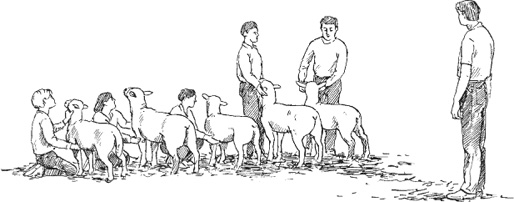
2. Lining up. When all exhibitors have entered the show ring, they turn their animals to line up before the judge. In most areas of the country, the sheep are lined up with their backsides facing the judge.
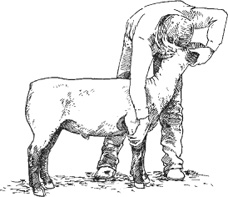
3. Squaring up. Once an exhibitor reaches the point where she will be on display, she takes a few moments to get her sheep standing well. The idea is to have the animal’s feet squarely placed under its body.
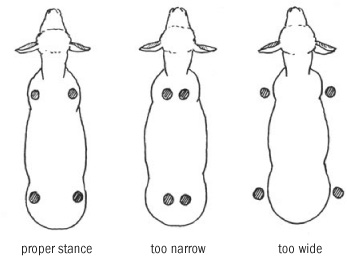
4. Proper foot placement. Properly squared-up sheep have their feet squarely planted under the four points of their body.
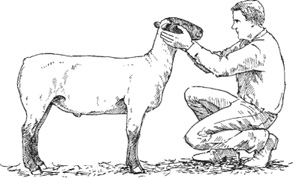
5. Squatting. This is the proper position for squatting with your sheep once it has been squared off for the judge to view.
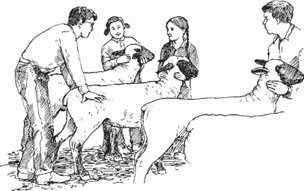
6. Bracing. When the judge comes up to closely inspect an individual exhibitor’s animal and feel along the sheep’s body, the exhibitor stands at the animal’s head and braces the animal so it doesn’t move.
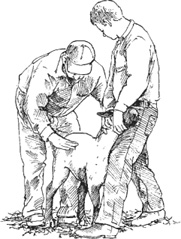
7. Alternate bracing. If the animal is particularly large and strong, an exhibitor may use his knee to help brace his animal.
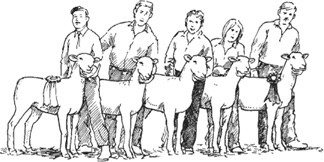
8. Final lineup. When the judge has made his selection, he will begin lining up animals in the order he plans to give the ribbons. At this point, the animals and the exhibitors face the judge.
Fitting
In sheep-show lingo, “fitting” is the name given to preshow preparation: trimming feet, shearing, washing, and carding. Fitting doesn’t start the day before the show — like training, it starts months before with early shearings, which result in the fleece’s being an optimum length for the show.
When early shearings should begin depends on the class of sheep and, to a certain extent, on the region of the country. But here are some rules of thumb: For meat and dual-purpose breeding animals, shearing is typically done the first time between 2 and 3 months before the show; market lambs are “slick-sheared” (completely sheared) about 2 weeks before the show. Wool breeds are shown “in fleece,” so they are slick-sheared 3 to 4 months prior to the show to ensure that their fleece is nicely grown out by show time. Putting a blanket or a coat on the sheep after shearing helps keep the fleece cleaner, especially for the wool breeds, and makes your later work a little easier, but it isn’t absolutely necessary.
The fitting work that takes place just before the show is most easily accomplished with the aid of a fitting stand, a wood-and-metal contraption that holds the sheep still in a standing position while you work on it. Occasionally, you have to lean over a sheep in a fitting stand, but most of your work can be done from a standing position. If you don’t have a fitting stand, you can tie off your sheep with a halter and work on the ground, but it becomes backbreaking work if you are doing more than one or two sheep! Animals should never be left unattended in a fitting stand (or when tied off) because they may hurt themselves. Have the supplies you’ll need at hand before you start, or have a helper who can retrieve that forgotten currycomb!
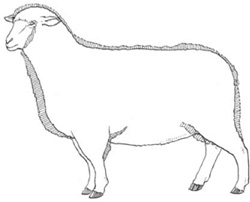
The shading indicates wool that is typically trimmed off when fitting a sheep for show. The goal in fitting is to have a nice consistent fleece length over the animal’s whole body.
One or two days before the show, for meat and dual-purpose breeds, clip the belly and the insides of the legs, then bathe and rinse the animal. For wool breeds, card the fleece well and lightly clip to shape the wool, then follow with a bath. This should be done a week to 10 days prior to the show, so there is plenty of time for the fleece to dry completely.
Warm water is preferable for washing, and as you’re working around the sheep’s head, try to keep both the soap and the water out of her eyes and ears (sheep hate it as much as people do). Use a hose with fairly light water pressure to wet down the animal. Place a small cube of mild hand soap — about 1 inch (2.5 cm) square — in an old empty dish-soap or squirt jar (this is part of the reuse, recycle, and reduce program), and fill with warm water. Shake well, then let it set for an hour or so. Shake it again to mix the soap and water, and begin applying evenly over the fleece with the squirt top.
Rub in the soap mixture well. An old terry cloth towel cut into a square works nicely. Make sure you get at those hard-to-hit spots, such as the belly and the insides of the legs.
Now it’s time to rinse. Get all the soap out of the fleece or it will dry in a weird, patchy manner that won’t win you any awards. Again, light water pressure is sufficient for rinsing.
When you’re done rinsing, remove the excess water with a clean round currycomb. Let your animal air-dry until the fleece is almost dry, and then place a show blanket on to keep her from getting debris or dirt in her fleece.
Sheep can be let out into a freshly bedded stall at this point to await final fitting, which is usually done within an hour of when they enter the ring.
Final Fitting
The final fitting consists of trimming and carding, and carding and trimming. This is like Fluffy’s day at the beauty salon.
Since market lambs were sheared 2 weeks before, they should still be pretty slick skinned. But if there are some spots where the shearer left a little more than other spots, use your hand shears, or blades, to clip them even.
Some market lambs are shown with a “poodle cut.” If you plan to show your lambs this way (and if the show allows it), tell the shearer not to clip the hips, rump, or dock in his earlier shearing. During final fitting, poodle cuts should be trimmed to about 1 inch (2.5 cm) long. This type of shearing job makes the animal look a little meatier around the rump, but many judges frown on it because show sheep are often going to be fed for another couple of months before they are butchered, and the uneven fleece at butcher time is less valuable than a fleece of one length.
Because they were sheared 2 or 3 months ago, breeding sheep usually have a nice regrowth of fleece. They should be trimmed so their fleece is about 1 inch (2.5 cm) all the way around.
Show Ring Strategies
When you’re at the show, watch some earlier classes of sheep being shown if you can. This will give you a chance to scope out the ring itself — you’ll want to avoid any low or damp spots in the ring if you can. Watch how the judge works.
Be on time when your class is called to enter the ring. Move your animal into the line, leaving 2 to 3 feet (61 to 91 cm) between you and the next exhibitor. Get Fluffy standing well, and get into your squat next to her.
Follow any directions the judge gives, and if he or she has you move around, then get Fluffy resquared and squat down again, quickly, after the judge has placed you in a new position. Judges often ask about your sheep’s breed and age or about your care and training. Be prepared to answer these questions by practicing before the show.
Always be polite to other exhibitors. And good luck!
 Registered breed shows, which are sponsored by the breed’s association or some other national sheep organization. These shows are often held in conjunction with state fairs and special expositions, such as the North American International Livestock Exposition and the National Western Stock Show. All animals must have current registration papers, and those papers must be up-to-date and accurate.
Registered breed shows, which are sponsored by the breed’s association or some other national sheep organization. These shows are often held in conjunction with state fairs and special expositions, such as the North American International Livestock Exposition and the National Western Stock Show. All animals must have current registration papers, and those papers must be up-to-date and accurate.








